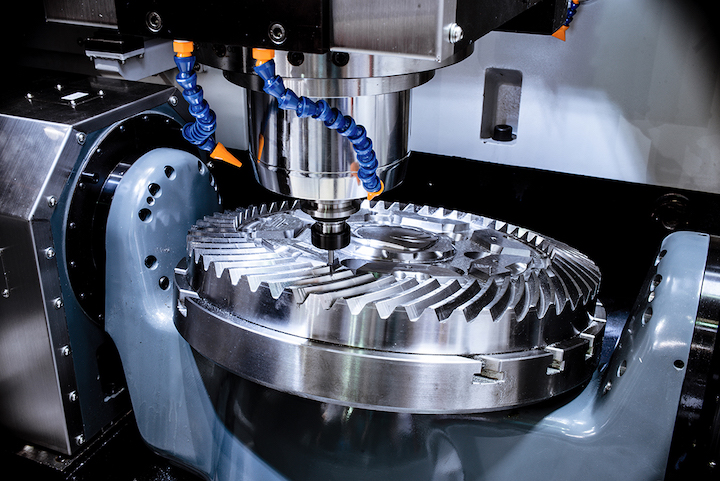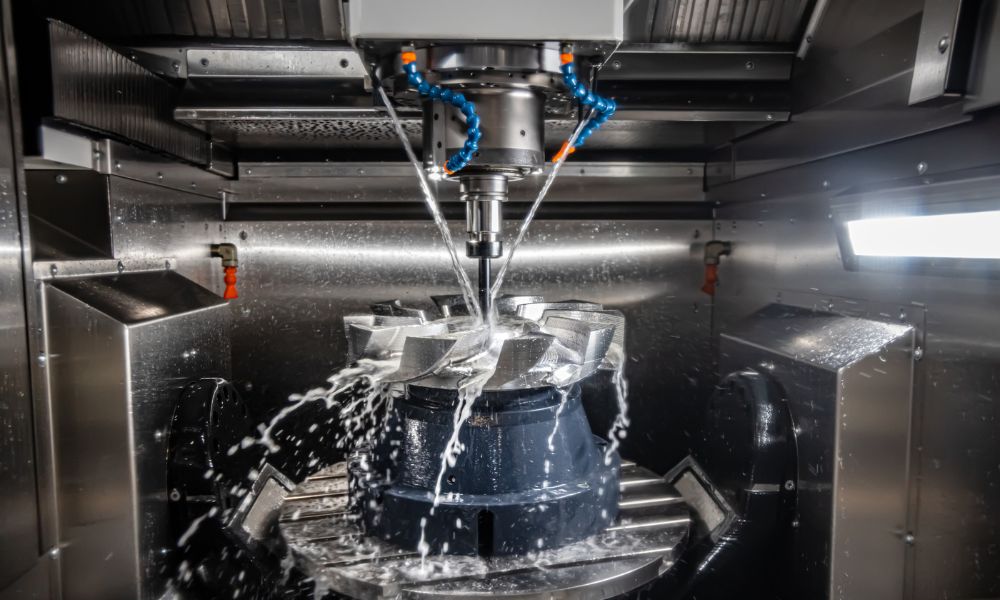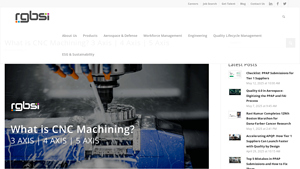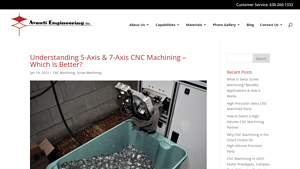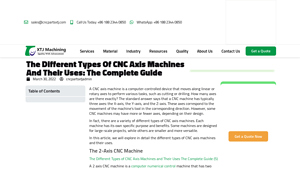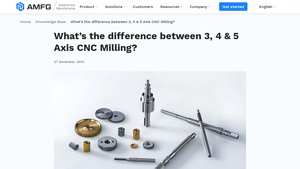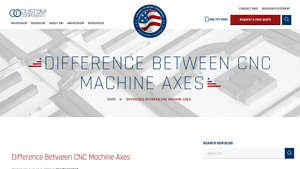Cnc Axis Guide: Type, Cost, Top List…
Introduction: Navigating the Global Market for cnc axis
In today’s rapidly evolving manufacturing landscape, sourcing CNC axes that meet specific operational needs poses a significant challenge for international B2B buyers. Whether you are in Africa, South America, the Middle East, or Europe, the intricacies of understanding different CNC machine configurations—ranging from 2-axis to advanced 5-axis systems—can be daunting. This guide is designed to demystify the world of CNC axes, providing a comprehensive overview of the various types, their applications, and the factors influencing procurement decisions.
From exploring the capabilities of each axis type to assessing the quality and reliability of suppliers, this guide empowers buyers to make informed purchasing decisions. You will learn about critical considerations such as cost factors, supplier vetting processes, and the importance of precision engineering in enhancing operational efficiency. Additionally, we will delve into the evolving market trends that influence CNC machine technology and its applications across diverse industries, including aerospace, automotive, and medical device manufacturing.
By the end of this guide, you will be equipped with actionable insights and practical knowledge to navigate the global market for CNC axes effectively. This ensures that you not only select the right equipment for your needs but also establish strong partnerships with trusted suppliers that can support your business objectives.
Understanding cnc axis Types and Variations
| Type Name | Key Distinguishing Features | Primary B2B Applications | Brief Pros & Cons for Buyers |
|---|---|---|---|
| 2-Axis CNC | Movement along X and Y axes | Basic part fabrication, engraving | Pros: Cost-effective, simple operation. Cons: Limited complexity and versatility. |
| 3-Axis CNC | Movement along X, Y, and Z axes | Precision machining, prototyping, and small parts | Pros: Greater accuracy, versatile. Cons: Limited to three sides of a workpiece. |
| 4-Axis CNC | Adds rotation around one linear axis (A-axis) | Complex geometries, aerospace, and automotive parts | Pros: Enhanced machining capabilities. Cons: Higher cost and complexity. |
| 5-Axis CNC | Rotates around two linear axes (A and B or C) | High-precision components, complex shapes | Pros: Superior accuracy and efficiency. Cons: Requires skilled operators, expensive. |
| Multi-Axis CNC | More than five axes, allowing intricate movements | Medical devices, molds, and custom parts | Pros: Extreme flexibility and capability. Cons: Significant investment and maintenance. |
What are the Characteristics of 2-Axis CNC Machines and Their B2B Suitability?
2-axis CNC machines are characterized by their ability to move along the X and Y axes, making them suitable for basic machining tasks such as cutting and engraving. These machines are often employed in industries like automotive and consumer electronics for producing simple parts and components. B2B buyers should consider the cost-effectiveness of 2-axis machines for straightforward projects, but they may find limitations in complexity and versatility when compared to more advanced options.
How Do 3-Axis CNC Machines Enhance Precision in Manufacturing?
3-axis CNC machines add the Z-axis to the existing X and Y movements, allowing for more intricate machining processes. This type is widely used for prototyping and manufacturing small parts in various industries, including aerospace and medical. Buyers should prioritize 3-axis CNC machines for their versatility and ability to handle a broader range of tasks, though they should be aware of the limitations in machining features on all sides of a workpiece.
What Advantages Do 4-Axis CNC Machines Offer for Complex Geometries?
4-axis CNC machines incorporate a rotary axis (A-axis) that enhances their ability to work on complex geometries. This feature allows for machining on additional sides of a workpiece, making them ideal for industries requiring precision, such as aerospace and automotive. B2B buyers should evaluate the increased capabilities of 4-axis machines against the higher costs and complexity they bring, ensuring they have the necessary skills and resources for operation.
Why are 5-Axis CNC Machines Essential for High-Precision Components?
5-axis CNC machines provide advanced machining capabilities by allowing rotation around two linear axes. This design enables the production of highly complex shapes and intricate parts, especially in sectors like medical device manufacturing. While these machines offer exceptional accuracy and efficiency, buyers must consider the investment required and the need for skilled operators to maximize their potential.
How Do Multi-Axis CNC Machines Support Custom Manufacturing Needs?
Multi-axis CNC machines, which feature more than five axes, are designed for extreme flexibility and capability in machining. They are particularly beneficial in producing custom parts, molds, and intricate medical devices. For B2B buyers, investing in multi-axis machines can lead to significant competitive advantages, but they should also be prepared for substantial initial costs and ongoing maintenance requirements.
Key Industrial Applications of cnc axis
| Industry/Sector | Specific Application of cnc axis | Value/Benefit for the Business | Key Sourcing Considerations for this Application |
|---|---|---|---|
| Aerospace | Precision Component Manufacturing | High accuracy and repeatability in complex parts | Certification standards, materials compatibility, lead time |
| Automotive | Engine and Transmission Parts Production | Enhanced efficiency and reduced waste in production | Supplier reliability, tooling capabilities, machine maintenance |
| Medical Devices | Custom Prosthetics and Implants | Tailored solutions for patient-specific needs | Regulatory compliance, material biocompatibility, precision requirements |
| Electronics Manufacturing | Circuit Board Fabrication | High-speed production with minimal errors | Technology integration, supply chain logistics, quality assurance |
| Construction and Heavy Machinery | Heavy Component Fabrication | Improved durability and precision in large parts | Machinery size and capacity, material sourcing, cost-effectiveness |
How is CNC Axis Utilized in Aerospace Component Manufacturing?
In the aerospace sector, CNC axis machines are vital for producing precision components such as turbine blades and structural parts. These machines operate with high accuracy, which is essential for meeting the stringent safety and performance standards of the industry. International buyers must consider sourcing CNC machines that comply with aviation regulations and certifications, ensuring that materials used can withstand extreme conditions. Additionally, the ability to produce complex geometries with minimal waste is a significant advantage for manufacturers looking to optimize production processes.
What Role Does CNC Axis Play in Automotive Parts Production?
CNC axis technology is extensively used in the automotive industry for manufacturing parts like engine blocks and transmission housings. The precision offered by CNC machines reduces material waste and enhances the fit and finish of components, leading to better overall vehicle performance. For B2B buyers, it’s crucial to assess the reliability of suppliers, their ability to handle various materials, and the maintenance of their CNC equipment to ensure consistent output quality and adherence to automotive standards.
How is CNC Axis Applied in Medical Device Manufacturing?
In the medical device industry, CNC axis machines enable the production of custom prosthetics and implants tailored to individual patients. This capability addresses the growing demand for personalized medical solutions while ensuring high precision and quality. Buyers in this sector must prioritize suppliers that demonstrate compliance with health regulations and standards, as well as those that can provide materials that are biocompatible and durable. The ability to produce intricate designs is essential for meeting specific patient needs.
How is CNC Axis Utilized in Electronics Manufacturing?
CNC axis machines are critical for the fabrication of circuit boards and electronic components, where precision and speed are paramount. The ability to produce complex designs with high accuracy minimizes errors and enhances product reliability. International buyers should focus on sourcing equipment that integrates well with existing technologies and can handle rapid production demands. Quality assurance processes and supply chain logistics are also vital considerations to ensure timely delivery and compliance with electronic standards.
What Advantages Does CNC Axis Offer in Heavy Machinery Fabrication?
In the construction and heavy machinery sector, CNC axis machines are used for fabricating large components such as frames and chassis. The precision and durability of parts produced through CNC machining lead to improved performance and longevity of machinery. Buyers in this field need to consider the size and capacity of CNC machines to handle large materials, as well as the sourcing of robust materials that can withstand harsh operating conditions. Cost-effectiveness and supplier reputation are also key factors in the decision-making process.
3 Common User Pain Points for ‘cnc axis’ & Their Solutions
Scenario 1: Navigating Complexity in Multi-Axis CNC Machining
The Problem: Many B2B buyers, particularly in sectors such as aerospace and automotive, face the challenge of selecting the right CNC machine with the appropriate axis configuration. As projects become increasingly complex, the need for precision and versatility grows. Buyers often find themselves overwhelmed by the options available, including 3-axis, 4-axis, and even 5-axis machines. This complexity can lead to costly mispurchases or underutilization of the equipment, impacting production schedules and overall project costs.
The Solution: To effectively navigate this complexity, buyers should start by clearly defining the specific requirements of their projects. Conducting a thorough analysis of the parts to be manufactured—including size, shape, and material—will provide crucial insights into the necessary capabilities of a CNC machine. Additionally, it is advisable to engage with suppliers who offer comprehensive consultations, allowing for a tailored recommendation based on the intended application.
Buyers should also consider investing in simulation software to visualize machining processes before making a purchase. Such tools can help identify potential issues in design and machining strategies, ensuring that the selected CNC machine aligns with production needs. Establishing a strong relationship with the supplier can also facilitate better understanding and support for ongoing maintenance and updates, ultimately enhancing the longevity and performance of the machine.
Scenario 2: Ensuring Consistent Precision Across Multiple Runs
The Problem: A common pain point for manufacturers is achieving consistent precision across multiple production runs. Variability in the machining process can lead to parts that do not meet specifications, resulting in increased waste and rework. This issue is particularly acute in industries where tolerances are tight, such as medical device manufacturing, where even minor deviations can have significant implications.
The Solution: To address this issue, manufacturers should implement a robust quality control system that incorporates regular calibration and maintenance of CNC machines. Establishing standard operating procedures (SOPs) for machine operation can also significantly reduce variability. This includes training operators thoroughly on the correct setup and tooling for each job.
Additionally, utilizing advanced CNC machines equipped with feedback systems can help monitor real-time performance and make necessary adjustments. Investing in software that integrates with CNC systems can provide valuable data analytics, allowing manufacturers to track performance trends and identify potential issues before they escalate. By proactively managing precision and maintaining machine performance, companies can ensure that every production run meets their quality standards.
Scenario 3: Overcoming the Challenge of Integration with Existing Systems
The Problem: B2B buyers often encounter difficulties when integrating new CNC machines with their existing manufacturing systems. This challenge can stem from various factors, including compatibility issues with software, tools, and other machinery. The result is often downtime, which can be particularly damaging in fast-paced environments where timely production is critical.
The Solution: To overcome integration challenges, buyers should prioritize compatibility during the selection process. Conducting a thorough assessment of current systems—including software platforms, tooling, and workflows—will provide a clearer picture of what is needed for seamless integration.
It is beneficial to work closely with vendors who understand the specific requirements of your existing infrastructure. Requesting demonstrations or trials of CNC machines can also help identify potential integration issues before purchase. Moreover, investing in training for staff on the new system can facilitate a smoother transition and minimize disruptions during the integration process.
Finally, consider establishing a phased implementation plan that allows for gradual integration, testing each component before full-scale deployment. This approach can significantly reduce the risks associated with introducing new technology into an established workflow, ensuring that production continues with minimal interruption.
Strategic Material Selection Guide for cnc axis
What Are the Key Properties of Common Materials Used in CNC Axes?
When selecting materials for CNC axes, it is crucial to consider their properties, as they directly influence the performance and longevity of the machine. Here, we analyze four common materials: Aluminum, Steel, Plastic (specifically, Polyoxymethylene or POM), and Titanium.
Aluminum: A Lightweight Option with Versatile Applications
Key Properties: Aluminum is known for its excellent strength-to-weight ratio, corrosion resistance, and good thermal conductivity. It typically has a temperature rating of up to 150°C and can withstand moderate pressures.
Pros & Cons: The lightweight nature of aluminum makes it easy to handle and reduces the overall weight of CNC machines. However, it may not be as durable as steel under heavy loads, which can be a limitation for high-stress applications. Its cost is generally moderate, making it a popular choice among manufacturers.
Impact on Application: Aluminum is suitable for applications requiring lightweight components, such as aerospace and automotive parts. Its corrosion resistance is beneficial in environments exposed to moisture.
Considerations for International Buyers: Buyers should ensure compliance with international standards such as ASTM B221 for aluminum extrusions. In regions like Africa and South America, sourcing aluminum may be easier due to its widespread availability.
Steel: The Heavy-Duty Workhorse
Key Properties: Steel offers high tensile strength, excellent durability, and resistance to wear and deformation. It can handle high temperatures (up to 400°C) and pressures, making it suitable for demanding applications.
Pros & Cons: The primary advantage of steel is its robustness, making it ideal for heavy-duty CNC machines. However, it is heavier than aluminum and can be more challenging to machine, leading to higher manufacturing costs. Steel is generally more expensive than aluminum but offers superior performance.
Impact on Application: Steel is commonly used in industries such as construction and heavy machinery, where strength and durability are paramount. Its ability to withstand high loads makes it suitable for components in CNC machines that require precision under stress.
Considerations for International Buyers: Compliance with standards like ASTM A36 is essential for steel components. Buyers in regions like the Middle East should also consider the availability of specific steel grades based on local manufacturing capabilities.
Plastic (POM): A Lightweight Alternative for Specific Applications
Key Properties: Polyoxymethylene (POM), also known as acetal, is characterized by its excellent dimensional stability, low friction, and resistance to wear. It operates effectively at temperatures up to 100°C and is resistant to many solvents.
Pros & Cons: POM is lightweight and easy to machine, making it an attractive option for applications requiring intricate designs. However, it may not be suitable for high-temperature environments or heavy loads, limiting its application scope. Its cost is generally lower than metals.
Impact on Application: POM is ideal for applications in the automotive and consumer goods sectors, where precision and low friction are critical. Its chemical resistance makes it suitable for environments where exposure to solvents is a concern.
Considerations for International Buyers: Buyers should ensure that POM components meet relevant standards such as ASTM D618. In Europe, compliance with REACH regulations is also essential for materials used in consumer products.
Titanium: The Premium Choice for Specialized Applications
Key Properties: Titanium is renowned for its exceptional strength-to-weight ratio, high corrosion resistance, and ability to withstand extreme temperatures (up to 600°C). It is non-magnetic and biocompatible, making it suitable for specialized applications.
Pros & Cons: While titanium offers unparalleled performance in demanding environments, its high cost and difficulty in machining can be significant drawbacks. It is typically more expensive than aluminum and steel, making it less accessible for budget-conscious projects.
Impact on Application: Titanium is often used in aerospace, medical devices, and high-performance automotive applications where weight savings and durability are critical. Its corrosion resistance makes it suitable for marine applications as well.
Considerations for International Buyers: Compliance with ASTM F136 for titanium used in medical applications is crucial. Buyers in regions like Saudi Arabia should also consider the availability of titanium alloys specific to their industry needs.
Summary Table of Material Selection for CNC Axes
| Material | Typical Use Case for cnc axis | Key Advantage | Key Disadvantage/Limitation | Relative Cost (Low/Med/High) |
|---|---|---|---|---|
| Aluminum | Aerospace and automotive components | Lightweight and corrosion-resistant | Less durable under heavy loads | Medium |
| Steel | Heavy machinery and construction applications | High strength and durability | Heavier and more challenging to machine | High |
| Plastic (POM) | Automotive and consumer goods | Low friction and easy to machine | Limited high-temperature performance | Low |
| Titanium | Aerospace and medical devices | Exceptional strength-to-weight ratio | High cost and difficult to machine | High |
This material selection guide provides a comprehensive overview for international B2B buyers, enabling informed decisions based on specific application needs and regional considerations.
In-depth Look: Manufacturing Processes and Quality Assurance for cnc axis
What Are the Main Stages in the Manufacturing Process for CNC Axes?
The manufacturing of CNC axes involves several critical stages, each contributing to the final product’s quality and performance. Understanding these stages can help B2B buyers make informed decisions when sourcing CNC machines.
Material Preparation: What Materials Are Used in CNC Axes Manufacturing?
The first step in the manufacturing process is material preparation. Common materials used for CNC axes include aluminum, steel, and various alloys. The selection of material depends on the intended application and required properties, such as strength, durability, and weight.
Once the materials are chosen, they are cut to size and shape, often using other CNC machines. This ensures high precision and consistency in dimensions. Additionally, surface treatments may be applied at this stage to enhance corrosion resistance and aesthetics.
How Are CNC Axes Formed During Manufacturing?
Following material preparation, the next stage is forming. This involves various techniques, including machining, welding, and casting.
-
Machining: This is the most common method, where CNC milling machines remove material from a solid block to create the desired shape of the axes. Techniques such as turning and grinding may also be employed for precision.
-
Welding: For more complex structures, welding is utilized to join different components together. This is especially relevant for multi-axis systems, where structural integrity is paramount.
-
Casting: In some cases, CNC axes may be cast from molten metal into pre-defined molds. This method can be cost-effective for large volumes but may require additional machining to achieve the desired precision.
What Assembly Processes Are Involved in CNC Axis Manufacturing?
After forming, the next phase is assembly. This stage typically includes the integration of linear and rotary components, such as motors, guides, and bearings, which are essential for the machine’s functionality.
Each assembly process should follow a systematic approach to ensure that all components fit perfectly and function as intended. Quality control checkpoints are often established during assembly to address any discrepancies immediately.
What Are the Finishing Techniques Used in CNC Axis Manufacturing?
The final stage in the manufacturing process is finishing. This may involve several techniques, including:
-
Surface Treatments: Anodizing or powder coating can be applied to improve the surface finish and protect against wear and corrosion.
-
Precision Testing: Each CNC axis is subjected to a series of tests to ensure that it meets the specified tolerances and performance standards.
-
Final Assembly: After finishing, the axes are often reassembled with other machine components to form a complete CNC system.
How Is Quality Assurance Ensured in CNC Axis Manufacturing?
Quality assurance (QA) is critical in CNC axis manufacturing, ensuring that the final product meets international standards and customer expectations.
What International Standards Should B2B Buyers Be Aware Of?
B2B buyers should familiarize themselves with relevant international standards, such as ISO 9001, which focuses on quality management systems. Compliance with these standards indicates that a manufacturer adheres to best practices in production and quality control.
Additionally, industry-specific certifications such as CE (for European markets) and API (for the oil and gas industry) can provide further assurance of product quality and safety.
What Are the Key Quality Control Checkpoints in CNC Manufacturing?
Quality control checkpoints are strategically placed throughout the manufacturing process. Common checkpoints include:
-
Incoming Quality Control (IQC): At this stage, raw materials are inspected for compliance with specifications before they are used in production.
-
In-Process Quality Control (IPQC): During manufacturing, ongoing inspections are conducted to ensure that processes remain within defined tolerances.
-
Final Quality Control (FQC): Once the product is assembled, a final inspection is performed to verify that the CNC axes meet all quality standards before shipment.
What Common Testing Methods Are Used in CNC Axis Quality Control?
Several testing methods are employed to ensure the quality and performance of CNC axes:
-
Dimensional Inspection: Utilizing calipers and coordinate measuring machines (CMM) to ensure that dimensions meet specified tolerances.
-
Functional Testing: Checking the operational capabilities of CNC axes to ensure they perform as expected under various conditions.
-
Load Testing: Subjecting the axes to stress tests to assess their strength and durability under operational loads.
How Can B2B Buyers Verify Supplier Quality Control?
B2B buyers can take several proactive steps to verify a supplier’s quality control processes:
-
Conduct Audits: Regular audits can provide insights into a supplier’s manufacturing practices and adherence to quality standards.
-
Request Quality Reports: Suppliers should be able to provide detailed quality reports, including data from inspections and tests conducted throughout the manufacturing process.
-
Engage Third-Party Inspectors: Hiring third-party inspectors can provide an unbiased assessment of a supplier’s quality control processes and product quality.
What Are the Quality Control Nuances for International B2B Buyers?
International buyers, particularly from diverse regions such as Africa, South America, the Middle East, and Europe, should be aware of specific quality control nuances:
-
Cultural Differences: Understand that quality standards and practices may vary significantly between regions. Familiarizing oneself with local industry standards can help bridge these gaps.
-
Logistical Considerations: International shipping can introduce risks to product quality. Buyers should ensure that suppliers have robust packaging and handling processes to protect products during transit.
-
Regulatory Compliance: Different regions may have varying regulations regarding product safety and quality. Buyers must ensure that their suppliers comply with these regulations to avoid potential legal issues.
In summary, understanding the manufacturing processes and quality assurance measures for CNC axes is essential for B2B buyers. By being knowledgeable about these aspects, buyers can make informed decisions, ensuring that they procure high-quality machines that meet their operational needs.
Practical Sourcing Guide: A Step-by-Step Checklist for ‘cnc axis’
Introduction
Navigating the procurement of CNC axis machines can be complex, especially for international B2B buyers. This checklist aims to streamline the sourcing process, ensuring you secure the right equipment tailored to your manufacturing needs. Each step is designed to enhance your decision-making and minimize risks associated with your investment.
Step 1: Define Your Technical Specifications
Before engaging with suppliers, clearly outline your technical requirements. Identify the specific type of CNC axis machine you need, whether it’s 2-axis, 3-axis, or multi-axis. Consider factors such as the materials you will be working with, the dimensions of the parts you intend to manufacture, and the level of precision required.
- Key Considerations: Determine whether you need linear axes, rotary axes, or a combination of both. This will influence your machine’s capabilities and overall performance.
Step 2: Research Potential Suppliers
Conduct thorough research to identify potential suppliers with a strong reputation in the CNC market. Look for manufacturers that specialize in CNC axis machines and have experience in your specific industry.
- Sources of Information: Utilize industry directories, trade shows, and online platforms such as LinkedIn to gather insights about various suppliers. Pay attention to their customer reviews and ratings.
Step 3: Verify Supplier Certifications
Ensure that your chosen suppliers have the necessary certifications that validate their manufacturing processes and quality standards. Certifications such as ISO 9001 can indicate a commitment to quality management.
- Importance of Certification: Certifications not only assure quality but also compliance with international standards, which is crucial for maintaining consistency and reliability in production.
Step 4: Request Detailed Quotations
Once you have shortlisted potential suppliers, request detailed quotations that include pricing, lead times, and warranty information. A well-detailed quote will allow you to compare different offers effectively.
- What to Look For: Ensure that the quotation specifies the machine’s capabilities, maintenance services, and any additional costs that may arise during operation.
Step 5: Evaluate After-Sales Support
Assess the level of after-sales support provided by the suppliers. This includes installation, training, and ongoing maintenance services. A strong support system can significantly reduce downtime and improve operational efficiency.
- Key Aspects: Inquire about the availability of spare parts, technical support, and training programs for your staff. Reliable support can enhance your machine’s longevity and performance.
Step 6: Conduct Site Visits
If possible, arrange site visits to the suppliers’ facilities. This allows you to observe their manufacturing processes and the quality of their products firsthand.
- What to Observe: Pay attention to their machinery, workforce capabilities, and overall production environment. A visit can provide valuable insights that are not evident through remote communications.
Step 7: Finalize the Contract Terms
Before finalizing your order, carefully review the contract terms. Ensure that all aspects of the agreement, including payment terms, delivery schedules, and warranty conditions, are clearly defined.
- Importance of Clarity: Having transparent contract terms helps mitigate risks and clarifies expectations on both sides, fostering a strong supplier relationship.
By following this checklist, B2B buyers can navigate the complex landscape of CNC axis procurement with greater confidence, ensuring they select the best machinery to meet their operational needs.
Comprehensive Cost and Pricing Analysis for cnc axis Sourcing
What Are the Key Cost Components in CNC Axis Sourcing?
When sourcing CNC axes, it is crucial to understand the various cost components that contribute to the overall pricing structure. Key elements include:
-
Materials: The choice of materials directly affects the cost. For instance, high-quality steel or aluminum may incur higher expenses but can improve durability and performance. The material’s availability and market price fluctuations can also influence costs significantly.
-
Labor: Labor costs encompass not only the workforce directly involved in manufacturing but also skilled operators for CNC machinery. Regions with higher labor costs, such as parts of Europe, may see increased pricing compared to regions with lower labor costs, like parts of South America and Africa.
-
Manufacturing Overhead: This includes utilities, equipment depreciation, and facility costs. Efficient manufacturing processes can help reduce overhead, leading to lower prices for buyers.
-
Tooling: Custom tooling can represent a significant upfront investment. Depending on the complexity of the CNC axes, tooling costs can vary widely. Buyers should consider these costs when evaluating overall pricing.
-
Quality Control (QC): Implementing rigorous QC processes ensures that the CNC axes meet specified tolerances and certifications. While this adds to the cost, it can prevent costly mistakes and enhance product reliability.
-
Logistics: Shipping and handling costs can vary based on the origin of the CNC axes, shipping routes, and delivery timelines. Buyers should account for potential tariffs and customs duties, especially when sourcing internationally.
-
Margin: Suppliers generally add a margin to cover their risks and expenses. Understanding typical margins in the CNC axis market can help buyers negotiate better terms.
How Do Price Influencers Impact CNC Axis Costs?
Several factors can influence the pricing of CNC axes, and understanding these can help buyers make informed purchasing decisions:
-
Volume/MOQ: Suppliers often have minimum order quantities (MOQs). Ordering in larger volumes typically reduces the per-unit cost due to economies of scale.
-
Specifications and Customization: Custom specifications can increase costs due to the need for specialized tooling or materials. Clear communication of requirements can help mitigate unexpected expenses.
-
Quality and Certifications: Products that meet higher quality standards or possess specific certifications may come at a premium but provide assurance of performance, especially in critical applications like aerospace or medical devices.
-
Supplier Factors: The supplier’s reputation, location, and production capabilities can all affect pricing. Established suppliers with a track record of reliability may charge more but offer better service and quality assurance.
-
Incoterms: Understanding Incoterms (International Commercial Terms) is essential for managing logistics costs. They define the responsibilities of buyers and sellers concerning shipping, insurance, and tariffs, impacting overall pricing.
What Are Effective Buyer Tips for Negotiating CNC Axis Prices?
To achieve cost-effective sourcing of CNC axes, buyers should consider the following strategies:
-
Negotiation: Leverage volume discounts and negotiate terms with suppliers. Building a relationship can often lead to better pricing and service.
-
Cost Efficiency: Assess the total cost of ownership (TCO), which includes initial costs, maintenance, and operational expenses. Lower upfront costs may lead to higher long-term expenses.
-
Pricing Nuances for International Buyers: Buyers from Africa, South America, the Middle East, and Europe should be aware of currency fluctuations, regional tariffs, and logistical challenges. Conducting thorough market research can provide insights into fair pricing.
-
Benchmarking: Compare quotes from multiple suppliers to ensure competitive pricing. Understanding market rates can empower buyers during negotiations.
Disclaimer on Indicative Prices
It is essential to note that the prices for CNC axes can vary widely based on market conditions, specific requirements, and the factors discussed above. Buyers should seek multiple quotes and conduct comprehensive due diligence to secure the best possible pricing.
Alternatives Analysis: Comparing cnc axis With Other Solutions
Understanding Alternatives to CNC Axis Technology
In the manufacturing sector, CNC (Computer Numerical Control) machines equipped with varying axes have become essential for precision machining. However, various alternative technologies and methods can also achieve similar results. This section compares CNC axis machines against two viable alternatives: traditional manual machining and additive manufacturing (3D printing). The comparison focuses on performance, cost, ease of implementation, maintenance, and best use cases.
Comparison Table
| Comparison Aspect | Cnc Axis | Traditional Manual Machining | Additive Manufacturing (3D Printing) |
|---|---|---|---|
| Performance | High precision and speed; suitable for complex geometries | Lower precision; limited complexity | Highly flexible; good for complex shapes but slower for large volumes |
| Cost | Higher initial investment; cost-effective for large production runs | Lower initial investment; variable costs based on labor and material | Moderate investment; cost-efficient for low-volume production |
| Ease of Implementation | Requires specialized training and software | Easier to implement with basic skills | Requires understanding of CAD software; can be complex to set up |
| Maintenance | Generally low; requires regular calibration and software updates | Higher; depends on machine wear and tear | Low; mainly maintenance of the printer and software |
| Best Use Case | Mass production of intricate parts in various industries | Prototyping and small-scale production | Rapid prototyping and custom parts |
Detailed Breakdown of Alternatives
1. Traditional Manual Machining
Manual machining relies on human skill to operate machines like lathes and milling machines. While this method can be cost-effective due to lower initial investments, it typically results in lower precision compared to CNC machines. Manual machining is best suited for simple parts and prototypes, where the need for high precision is not critical. However, it can become labor-intensive and may lead to increased production times. The flexibility of manual machining allows for quick adjustments, but it lacks the repeatability and speed of CNC technology.
2. Additive Manufacturing (3D Printing)
Additive manufacturing, or 3D printing, offers significant advantages in flexibility and complexity of design. This technology builds parts layer by layer, allowing for intricate geometries that would be difficult to achieve with traditional machining. It is particularly effective for low-volume production and rapid prototyping. However, the speed of production can be slower compared to CNC machining, especially for larger parts. Additionally, the cost per part can be higher for larger production runs, making it less suitable for mass production compared to CNC axis machines.
Conclusion: Choosing the Right Solution for Your Needs
When evaluating the best solution for your manufacturing needs, it is essential to consider your specific requirements, including production volume, complexity of parts, and budget. CNC axis machines are ideal for high-precision, mass production scenarios where efficiency is crucial. On the other hand, traditional manual machining may be more appropriate for low-volume, less complex tasks. Lastly, if rapid prototyping and custom design flexibility are priorities, additive manufacturing could be the best choice. Understanding these alternatives enables B2B buyers to make informed decisions that align with their operational goals and market demands.
Essential Technical Properties and Trade Terminology for cnc axis
What Are the Key Technical Properties of CNC Axes?
Understanding the technical properties of CNC axes is essential for B2B buyers who aim to make informed decisions regarding their manufacturing processes. Here are several critical specifications that should be considered:
-
Material Grade
– The material grade of CNC machine components, such as the axes themselves, significantly influences durability and performance. Common materials include stainless steel, aluminum, and high-grade plastics. Selecting the right material can enhance the machine’s longevity and reduce maintenance costs, which is crucial for operations in demanding environments. -
Tolerance
– Tolerance refers to the permissible limit of variation in a physical dimension. In CNC machining, tighter tolerances (e.g., ±0.01 mm) indicate higher precision, which is vital for industries such as aerospace and medical device manufacturing where exact specifications are non-negotiable. Understanding the required tolerance levels can help buyers assess the capabilities of various CNC machines. -
Axis Configuration
– The configuration of the axes (2-axis, 3-axis, 4-axis, or 5-axis) directly affects the complexity of parts that can be manufactured. For example, a 5-axis machine allows for more intricate designs and can work on multiple sides of a part simultaneously. This flexibility is essential for industries that demand high precision and complex geometries. -
Speed and Feed Rate
– Speed refers to the rate at which the CNC machine can operate, while feed rate indicates how quickly the cutting tool moves through the material. Both parameters affect production efficiency and the quality of the finished product. For B2B buyers, understanding these metrics helps in selecting machines that align with production goals and timelines. -
Repeatability
– Repeatability is the ability of a CNC machine to produce the same part consistently over multiple cycles. High repeatability is crucial for mass production environments where uniformity is key. Buyers should inquire about the repeatability specifications when evaluating machines to ensure they can meet their production requirements. -
Control System
– The type of control system (e.g., G-code, M-code) used in CNC machines impacts ease of use and programming capabilities. Advanced control systems may offer better user interfaces and more sophisticated programming options, enhancing operational efficiency and reducing training time for staff.
What Are Common Trade Terms Related to CNC Axes?
Familiarity with industry jargon can streamline communication and negotiations in the B2B space. Here are several essential trade terms:
-
OEM (Original Equipment Manufacturer)
– An OEM refers to a company that manufactures parts or equipment that may be marketed by another company. In the context of CNC axes, understanding who the OEM is can help buyers assess product quality and support services. -
MOQ (Minimum Order Quantity)
– MOQ is the smallest quantity of a product that a supplier is willing to sell. For CNC machine components, knowing the MOQ helps buyers plan their inventory and manage costs effectively, especially when entering new markets. -
RFQ (Request for Quotation)
– An RFQ is a formal document requesting pricing, delivery terms, and other details from suppliers. Submitting an RFQ is crucial for buyers looking to compare options and negotiate favorable terms for CNC machines or components. -
Incoterms (International Commercial Terms)
– Incoterms are a set of internationally recognized rules that define the responsibilities of buyers and sellers in global trade. Understanding these terms is essential for B2B transactions, especially when dealing with international suppliers of CNC machines. -
Lead Time
– Lead time is the amount of time it takes from placing an order to receiving the product. Knowing the lead time for CNC machines and components is important for production planning and ensuring that projects stay on schedule. -
Takt Time
– Takt time is the maximum allowable time to produce a product to meet customer demand. This metric is critical for manufacturers to balance production rates with market needs, ensuring efficiency in operations.
By understanding these technical properties and trade terms, B2B buyers can make more informed purchasing decisions regarding CNC axes, aligning their choices with operational goals and market demands.
Navigating Market Dynamics and Sourcing Trends in the cnc axis Sector
What Are the Key Market Trends Influencing the CNC Axis Sector?
The CNC axis sector is experiencing dynamic growth driven by several global factors. A significant driver is the increasing demand for precision manufacturing across industries such as aerospace, automotive, and medical devices. As international markets expand, especially in regions like Africa, South America, the Middle East, and Europe, businesses are increasingly investing in advanced CNC technologies to enhance production efficiency and reduce lead times. Emerging technologies, such as Industry 4.0 and the Internet of Things (IoT), are transforming CNC operations by facilitating real-time monitoring and predictive maintenance, allowing manufacturers to optimize their processes.
Sourcing trends are also evolving. International B2B buyers are looking for suppliers that offer not only high-quality machinery but also integrated solutions that encompass software and support services. The shift towards automation and robotics in CNC machining is gaining traction, leading to the rise of collaborative robots (cobots) that can work alongside human operators, improving productivity without compromising safety. Furthermore, there is a notable trend towards modular and customizable CNC systems, enabling businesses to tailor their equipment to specific production requirements.
How Can Sustainability and Ethical Sourcing Impact B2B Operations in the CNC Axis Sector?
Sustainability has become a critical consideration for B2B buyers in the CNC axis sector. Companies are increasingly aware of the environmental impacts associated with manufacturing processes, including energy consumption and waste generation. To address these concerns, manufacturers are adopting eco-friendly practices, such as using energy-efficient CNC machines and sustainable materials. This shift not only helps in reducing the carbon footprint but also aligns with the growing consumer demand for environmentally responsible products.
Ethical sourcing is equally important, as buyers seek suppliers who adhere to fair labor practices and maintain transparency in their supply chains. Certifications such as ISO 14001 for environmental management and ISO 45001 for occupational health and safety are becoming essential for suppliers aiming to demonstrate their commitment to sustainability. Additionally, the use of green materials, such as recycled metals and biodegradable composites, is gaining traction, providing buyers with options that fulfill both performance and environmental criteria.
How Has the CNC Axis Technology Evolved Over Time?
The evolution of CNC axis technology has been marked by significant advancements since its inception in the mid-20th century. Initially, CNC machines primarily operated on a limited number of axes, typically two or three, which restricted their capabilities. Over the years, the development of multi-axis machines, including 4-axis and 5-axis systems, has revolutionized machining processes. These advanced machines allow for complex geometries and intricate designs, making them indispensable in industries that require high precision.
The integration of computer-aided design (CAD) and computer-aided manufacturing (CAM) systems has further enhanced the capabilities of CNC machines, enabling seamless design-to-production workflows. As technology continues to advance, the future of CNC machining looks promising, with ongoing innovations in automation, AI, and machine learning expected to drive further efficiencies and capabilities in the sector. This evolution presents a wealth of opportunities for B2B buyers to leverage cutting-edge technologies for competitive advantage.
Frequently Asked Questions (FAQs) for B2B Buyers of cnc axis
-
How do I choose the right CNC axis machine for my needs?
Selecting the appropriate CNC axis machine involves assessing your specific manufacturing requirements. Consider factors such as the complexity of the parts you need to produce, the materials you’ll be working with, and the desired precision. A 2-axis machine may suffice for simple shapes, while a 5-axis machine is ideal for intricate geometries and tighter tolerances. Additionally, evaluate your production volume and whether you need customization options to tailor the machine to your processes. -
What are the key differences between 2-axis and 5-axis CNC machines?
The primary difference lies in the number of sides that can be machined simultaneously. A 2-axis CNC machine operates on two linear axes, typically allowing for movement along the X and Y axes, suitable for simpler tasks. In contrast, a 5-axis machine incorporates additional rotary axes (A, B, C) that enable machining on multiple sides of a workpiece in a single setup, significantly enhancing efficiency and accuracy for complex parts. -
What customization options should I consider when sourcing CNC axis machines?
When sourcing CNC axis machines, inquire about customization options such as software compatibility, tooling adaptability, and machine size. You may also need features like automatic tool changers, enhanced spindle speeds, or specific safety protocols. Working with suppliers that offer customizable solutions can ensure that the machine aligns with your unique production processes and improves overall efficiency. -
What minimum order quantities (MOQs) should I expect when sourcing CNC machines?
MOQs for CNC machines can vary significantly based on the manufacturer and the complexity of the machine. Generally, larger manufacturers may have higher MOQs, often requiring orders of several units, while smaller suppliers might accommodate lower quantities. It’s essential to communicate your needs clearly with potential suppliers to negotiate favorable terms that match your production scale. -
What payment terms are common in international CNC machine transactions?
Payment terms can vary widely, but common practices include upfront deposits (typically 30-50%) with the balance due upon delivery or installation. Some suppliers may offer financing options or letters of credit to facilitate transactions. Ensure to discuss these terms upfront and consider using secure payment methods to protect your investment. -
How can I vet suppliers when sourcing CNC axis machines internationally?
Vetting suppliers involves several steps: check their certifications (e.g., ISO), review customer testimonials, and assess their manufacturing capabilities. Additionally, consider requesting sample parts to evaluate quality. Engaging with suppliers via video calls or site visits can provide deeper insights into their operations. Networking with other businesses in your industry can also yield valuable recommendations. -
What quality assurance measures should I expect from CNC machine suppliers?
Quality assurance measures can include rigorous testing protocols, compliance with international standards, and detailed inspection reports for each machine. Look for suppliers that offer warranties and after-sales support, as these are indicators of their commitment to quality. It’s advisable to request documentation of their QA processes to ensure that the machines meet your specifications before purchase. -
What logistics considerations should I keep in mind when importing CNC machines?
Logistics considerations include shipping methods, customs clearance, and delivery timelines. Determine whether the supplier offers DDP (Delivered Duty Paid) terms to simplify the import process. Additionally, consider the availability of local support for installation and maintenance. Partnering with a reliable logistics provider can help manage these complexities and ensure timely delivery of your machinery.
Important Disclaimer & Terms of Use
⚠️ Important Disclaimer
The information provided in this guide, including content regarding manufacturers, technical specifications, and market analysis, is for informational and educational purposes only. It does not constitute professional procurement advice, financial advice, or legal advice.
While we have made every effort to ensure the accuracy and timeliness of the information, we are not responsible for any errors, omissions, or outdated information. Market conditions, company details, and technical standards are subject to change.
B2B buyers must conduct their own independent and thorough due diligence before making any purchasing decisions. This includes contacting suppliers directly, verifying certifications, requesting samples, and seeking professional consultation. The risk of relying on any information in this guide is borne solely by the reader.
Top 8 Cnc Axis Manufacturers & Suppliers List
1. RGBSI – CNC Machining Solutions
Domain: blog.rgbsi.com
Registered: 1997 (28 years)
Introduction: CNC (computer numerical control) machining is a manufacturing process where programmed computer software directs the motions of machinery and tools. It automates techniques like milling, water jet cutting, and laser cutting. CNC machines operate along multiple axes: 3 Axis (X, Y, Z), 4 Axis (X, Y, Z, A), and 5 Axis (X, Y, Z, and two of A, B, C). 3 Axis machining is suitable for parts needing less …
2. Avant Engineering – 5-Axis CNC Machining
Domain: avantiengineering.com
Registered: 2000 (25 years)
Introduction: 5-Axis CNC Machining:
– Moves along five axes: X (vertical rotation), Y (horizontal rotation), Z (depth), A (X axis revolution), B (Y revolution).
– Benefits: Increased precision, time savings, cost savings, improved accuracy.
– Commonly used in aerospace, automotive, medical device manufacturing, and auto parts manufacturing.
7-Axis CNC Machining:
– Moves along seven axes: X, Y, Z, A, B, C (Z-…
3. CNC Parts XTJ – Precision CNC Axis Machines
Domain: cncpartsxtj.com
Registered: 2019 (6 years)
Introduction: CNC Axis Machines: 2-Axis, 3-Axis, 4-Axis; Uses: Cutting, drilling, engraving; Industries: Automotive, Aerospace, Medical, Consumer Electronics; Benefits: Improved accuracy, reduced production time, increased repeatability, wider material range, faster waste removal; Cost: Varies by type, size, features; 2-Axis: X and Y movement, versatile for simple to complex designs; 3-Axis: Adds Z-axis for mor…
4. Sybridge – 3-Axis CNC Machining
Domain: sybridge.com
Registered: 2003 (22 years)
Introduction: 3-Axis CNC Machining:
– Operates along three axes: X, Y, and Z.
– Material block remains fixed; cutting tools move to remove excess material.
– Suitable for producing simple geometries and parts.
– CNC milling and CNC turning are included.
– CNC turning is faster and cheaper for high-volume production.
– Struggles with complex shapes and may require manual repositioning, increasing costs and…
5. Reddit – 9 Axis CNC Machines
Domain: reddit.com
Registered: 2005 (20 years)
Introduction: A 9 axis CNC machine typically consists of a full spindle 6 axis combined with an indexed 3 axis. It is often associated with Swiss-style lathes, which can include features such as dual spindles, lower turrets for milling/turning, and the ability to perform live milling. These machines can handle multiple code paths simultaneously, with some Fanuc controllers capable of managing 16 code paths and …
6. AMFG – Advanced CNC Milling Solutions
Domain: amfg.ai
Registered: 2018 (7 years)
Introduction: 3-axis CNC milling: Fixed workpiece, spindle moves along X, Y, Z axes; ideal for simple designs, shallow features, and planar profiles. 4-axis CNC milling: Adds A-axis for rotation around X-axis, enhances precision and speed, suitable for parts feasible on 3-axis machines. 5-axis CNC milling: Utilizes two of three possible rotation axes (A, B, C), processes multiple sides without repositioning wor…
7. Axis CNC – High-Quality Machining Services
Domain: axiscncinc.net
Registered: 2014 (11 years)
Introduction: Axis Cnc Incorporated provides high-quality manufacturing, machining, and programming services. They specialize in rapid prototyping, short-run, and high-volume machining projects. The company emphasizes quality, on-time delivery, and competitive pricing. They manage entire projects and ensure products are shipped to specification.
8. American Micro Inc – CNC Machining Solutions
Domain: americanmicroinc.com
Registered: 2001 (24 years)
Introduction: CNC machines utilize various axis counts, typically ranging from three to five axes. Three-axis CNC machining operates along an XYZ plane (X: vertical, Y: horizontal, Z: depth) and is suitable for tasks like milling slots, drilling, and creating edges. It is simpler and requires less setup time, making it ideal for shallow cuts. Four-axis CNC machining adds an additional cutting direction, enhanci…
Strategic Sourcing Conclusion and Outlook for cnc axis
What Are the Key Takeaways for B2B Buyers in CNC Axis Sourcing?
In the competitive landscape of CNC machining, understanding the variety of CNC axis machines is essential for making informed purchasing decisions. The choice between 2-axis, 3-axis, and multi-axis machines directly impacts production capabilities, precision, and efficiency. For B2B buyers, strategic sourcing not only involves evaluating machine specifications but also considering the long-term value, including maintenance costs and technological advancements.
How Can Strategic Sourcing Enhance Operational Efficiency?
Effective strategic sourcing can significantly enhance operational efficiency. Buyers should prioritize suppliers that offer comprehensive support, from installation to ongoing training, ensuring that their teams can maximize the capabilities of their CNC systems. Furthermore, forging strong relationships with manufacturers can lead to better pricing, exclusive access to innovations, and tailored solutions that meet specific business needs.
What Lies Ahead for CNC Axis Technology and Market Opportunities?
As the global demand for precision manufacturing continues to rise, investing in advanced CNC technology is crucial for staying competitive. Buyers from Africa, South America, the Middle East, and Europe should actively seek partnerships with reputable suppliers who can provide cutting-edge solutions. By embracing the latest advancements in CNC axis technology, businesses can drive growth, enhance product quality, and achieve operational excellence. Now is the time to act—evaluate your options, engage with trusted suppliers, and position your business for future success in the dynamic world of CNC machining.
